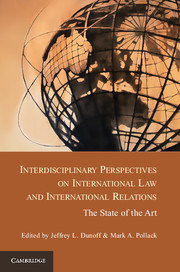 Interdisciplinary Perspectives on International Law and International Relations
Interdisciplinary Perspectives on International Law and International Relations Book contents
- Frontmatter
- Contents
- Contributors
- Acknowledgments
- Part I Introduction: Setting the Stage
- Part II Theorizing International Law
- Part III Making International Law
- Part IV The Interpretation and Application of International Law
- Part V Enforcement, Compliance, and Effectiveness
- 19 The Engines of Compliance
- 20 Coercive Enforcement of International Law
- 21 Reputation in International Relations and International Law Theory
- 22 Open Economy Law
- 23 Persuading to Comply
- 24 Against Compliance
- Conclusions
- Index
- References
19 - The Engines of Compliance
Published online by Cambridge University Press: 05 January 2013
- Frontmatter
- Contents
- Contributors
- Acknowledgments
- Part I Introduction: Setting the Stage
- Part II Theorizing International Law
- Part III Making International Law
- Part IV The Interpretation and Application of International Law
- Part V Enforcement, Compliance, and Effectiveness
- 19 The Engines of Compliance
- 20 Coercive Enforcement of International Law
- 21 Reputation in International Relations and International Law Theory
- 22 Open Economy Law
- 23 Persuading to Comply
- 24 Against Compliance
- Conclusions
- Index
- References
Summary
Compliance with international law (IL) has long puzzled scholars and policy-makers. For decades, debates centered around the question of whether IL was even law at all, given its lack of an overarching enforcer (Morgenthau 1948; Hart 1961). Later, international relations (IR) scholars showed that international cooperation was not only possible and sustainable, but also common (Axelrod 1984; Axelrod and Keohane 1986). Around the same time, Henkin (1979: 47) famously stated, “it is probably the case that almost all nations observe almost all principles of international law and almost all of their obligations almost all of the time” (italics in original). But, by and large, most scholars agreed that it was puzzling – even surprising – that states ever abided by their international legal commitments (Keohane 1984: 99; Franck 1988: 705).
Why do – and don't – states comply with international rules? If we do observe compliance, what does this tell us about laws' usefulness as a tool for effecting real changes in how governments treat their citizens, whether they defend their partners when war breaks out, how they apply antidumping measures, and whether they curb pollution? International law scholars have long been interested in compliance. Political scientists have considered compliance with international law puzzling for decades, if not longer, but even ten years ago these questions rarely received in-depth attention in the literature. This has changed dramatically. Across both fields, scholars are interested in how governments use laws to structure their relations with one another, and why, if at all, governments abide by those rules.
- Type
- Chapter
- Information
- Interdisciplinary Perspectives on International Law and International RelationsThe State of the Art, pp. 477 - 501Publisher: Cambridge University PressPrint publication year: 2012
References
- 8
- Cited by


